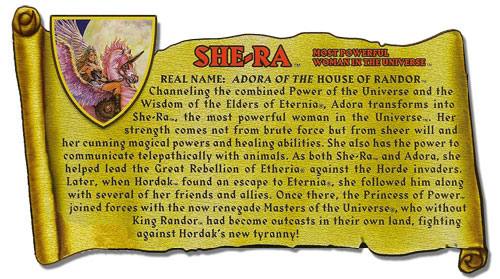Inspired by He-Man.org’s Roast Gooble Dinner podcast, welcome to PGPoA’s latest MOTUC Bio Discussion!

She-Raâ„¢ Bio
Real Name: Adora of the House of Randor
Channeling the combined Power of the Universe and the Wisdom of the Elders of Eternia, Adora transforms into She-Raâ„¢, the Most Powerful Woman in the Universeâ„¢. Her strength comes not from brute force but from sheer will and her cunning magical powers and healing abilities. She also has the power to communicate telepathically with animals. As both She-Raâ„¢ and Adora, she helped lead the Great Rebellion of Etheria against the Horde invaders. Later, when Hordakâ„¢ found an escape to Eternia, she followed him along with several of her friends and allies. Once there, the Princess of Powerâ„¢ joined forces with the now renegade Masters of the Universe, who without King Randorâ„¢ had become outcasts in their own land, fighting against Hordak’s new tyranny!
Portrait Art Source: Vintage She-Ra poster (via MOTUCPortal)
When She-Ra’s bio was initially revealed, some fans took issue with the phrasing that “her strength comes not from brute force but from sheer will and cunning magical powers and healing abilities.” These fans interpreted this to mean She-Ra was somehow weaker than He-Man, and that it was reinforcing sexist stereotypes. Well, both of those things might be true, but Scott Neitlich is right when he states that those lines come straight from official POP marketing text. And as much as one could read it as “She-Ra is weaker than He-Man,” one could also read it as, “He-Man is a thick-headed jock who fixed problems by punching them” while She-Ra is “cunning” and wields magical powers. (I dare anyone to make a compelling argument that the overall example of He-Man in the Filmation series is that problems are best solved by an application of brute force, preferably punching.)
It’s tough that Adora/She-Ra had to lead the Great Rebellion against the Horde invaders–you know, the ones that were sent there by her own ancestor, King Grayskull. On a side note, I wonder if–through the vagaries of cross-dimensional time and space–King Grayskull’s banishment of the Horde to Despondos caused Hordak to arrive in Despondos just a few years before Adam and Adora were born? Sort of a relativistic effect, perhaps. I’m just looking for an explanation as to how Hordak survives the five hundred years between King Grayskull and Randor, unless he’s just a long-lived creature.
Now, the last part of this bio is the most interesting, and to be honest I’d totally forgotten about it. The idea of the Heroic Warriors being outcasts in their own land was part of the Four Horsemen’s original pitch for the 200X revamp. However, in the Horsemen’s version, it was Skeletor who had ousted Randor and the heroes, not Hordak. So it’s possible this idea is based not on the Four Horsemen’s pitch, but on the unproduced third and fourth seasons of the 200X cartoon.
In any event, the idea of the heroes of Eternia being on the defensive is intriguing. Of course, we already know that Skeletor comes out on top and then takes off to conquer the galaxy…leaving one to wonder exactly what happens to Eternia. I suppose the heroes defeat the Horde, possibly with Skeletor betraying/defeating Hordak at the last moment, and then rather than confronting the heroes, Skeletor simply takes off to conquer the Horde (planning to return to Eternia with the Horde behind him someday).
Of course, this is all speculation. Still, that’s one heck of an interesting plot line they’ve opened up here.
